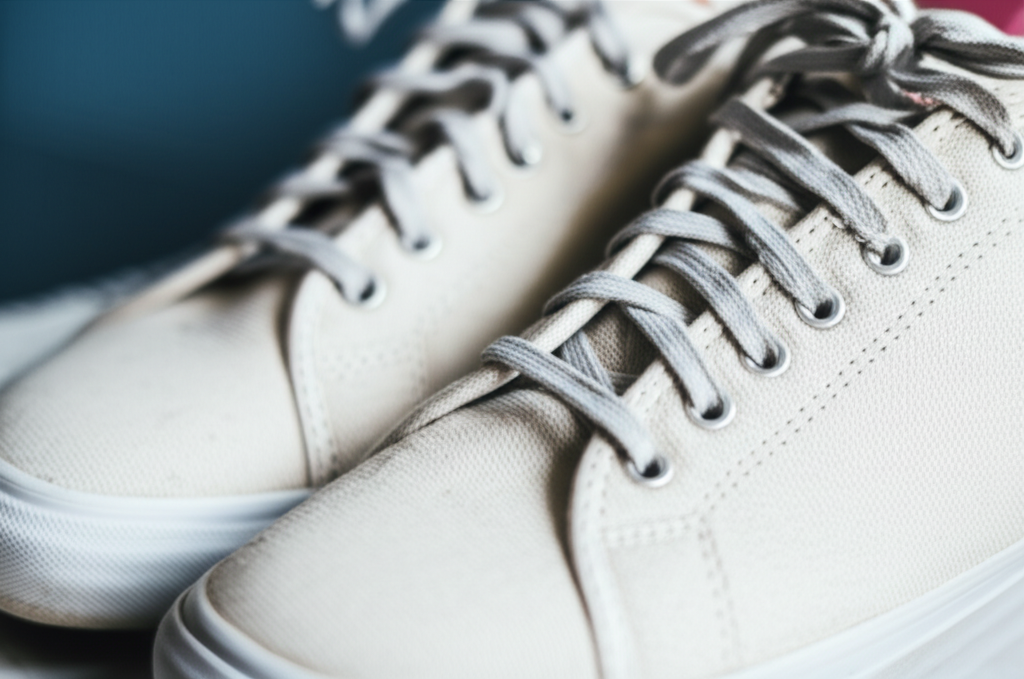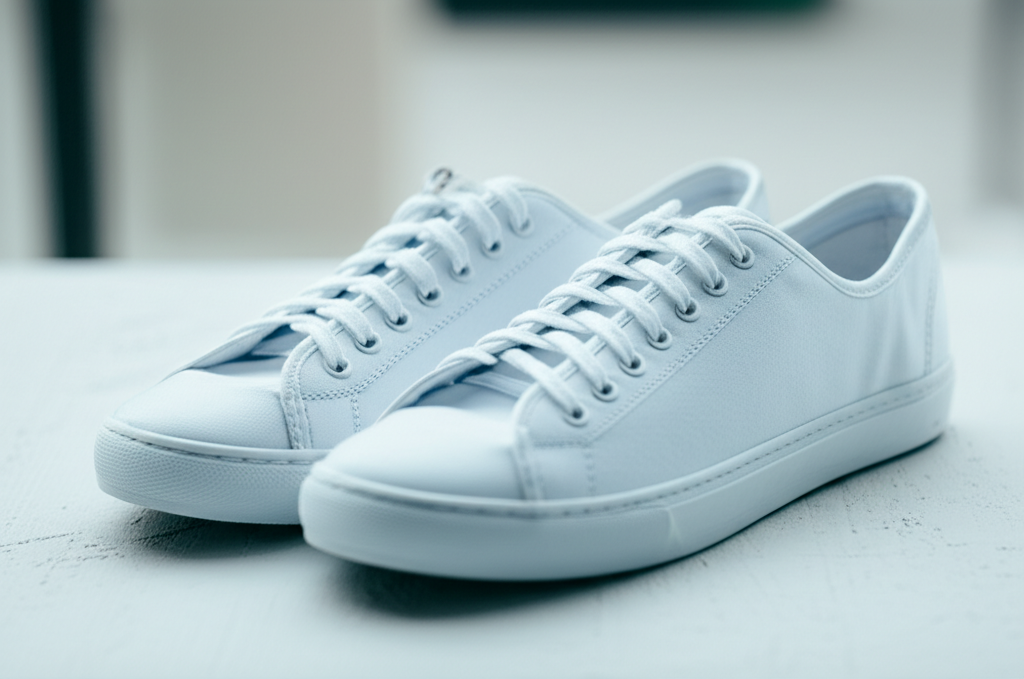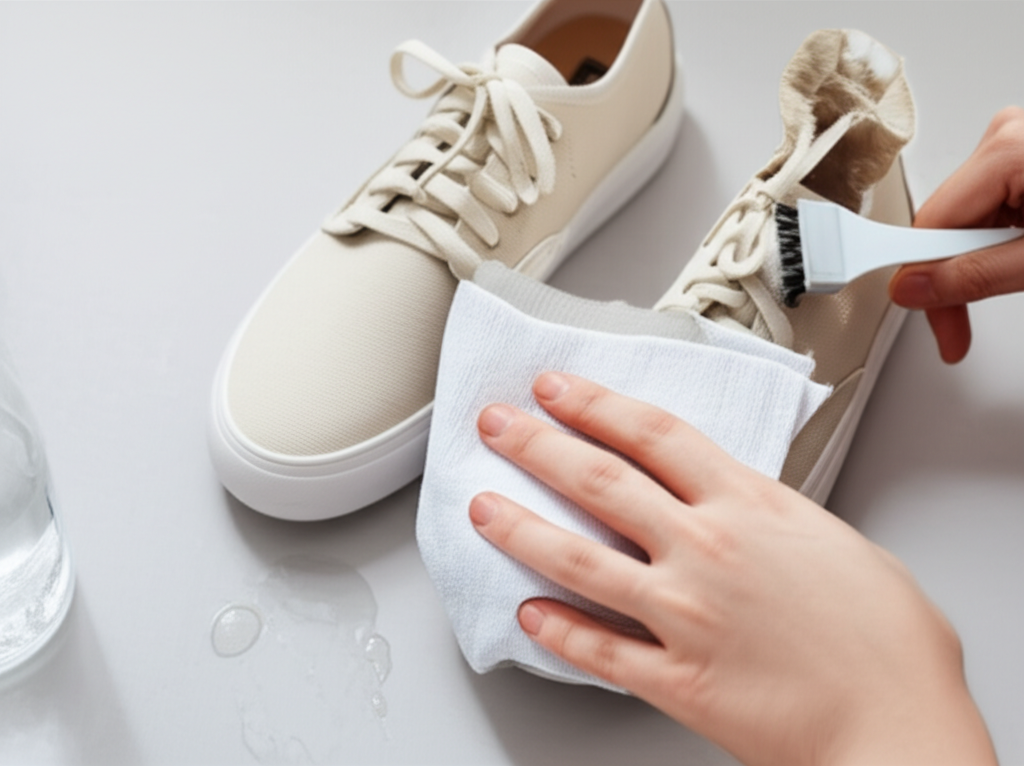Effortlessly restore your favorite fabric shoes to their former glory with our simple guide on how to clean fabric shoes, ensuring they look fresh and vibrant with minimal fuss.
Key Takeaways
- Pre-treat stubborn stains for better results.
- Use mild cleaning solutions to protect fabric.
- Gentle scrubbing preserves shoe integrity.
- Air dry shoes to prevent shrinking or damage.
- Regular cleaning extends shoe lifespan.
- Test cleaning methods on inconspicuous areas first.
How to Clean Fabric Shoes: Effortless Shine for Your Footwear
Do your favorite fabric shoes look a little worn out? Stains, dirt, and general grime can make even the most stylish sneakers appear dull. It’s easy to feel overwhelmed, wondering if they can ever look clean again. Many people think cleaning fabric shoes is complicated or requires expensive products. But the truth is, with the right approach and a few common household items, you can achieve an effortless shine and make your fabric shoes look like new. This guide will walk you through simple, effective steps to bring back the sparkle to your beloved footwear.
Gather Your Shoe Cleaning Supplies

Before you start, having the right tools makes the entire process smoother. You don’t need a professional kit; most items can be found around your home. Having these ready will prevent interruptions and ensure you can tackle the cleaning efficiently.
Essential Cleaning Tools
- Soft-bristled brush: An old toothbrush or a dedicated shoe brush works wonders.
- Microfiber cloths: For wiping and drying.
- Mild detergent or shoe cleaner: Gentle soap is key.
- Water: Cool or lukewarm is best.
- Bowl: For mixing cleaning solutions.
- Magic eraser or melamine sponge: For scuffs on soles.
- Optional: Baking soda or white vinegar: For tougher stains and odors.
- Optional: Shoe trees or paper towels: To help shoes keep their shape while drying.
Step-by-Step Guide: Cleaning Your Fabric Shoes
Cleaning fabric shoes doesn’t have to be a chore. Follow these straightforward steps to bring them back to life. We’ll cover everything from removing dust to tackling tough stains, ensuring your shoes get the care they deserve without damaging the material.
Step 1: Prepare Your Shoes
Start by removing loose dirt and debris. This is a crucial first step that prevents you from just pushing dirt around later. Bang the soles of your shoes together gently to dislodge any packed-in dirt. Then, use a dry, soft-bristled brush to brush away any surface dust or mud from the uppers and soles. Pay attention to the crevices and seams where dirt often accumulates.
Step 2: Pre-treat Stains
For any visible stains, pre-treatment is highly effective. Apply a small amount of your chosen cleaning solution directly to the stained area. Let it sit for a few minutes to begin breaking down the stain. For tougher stains, you might consider a paste of baking soda and water, or a diluted solution of white vinegar. Always test the cleaning solution on an inconspicuous area of the shoe first to ensure it doesn’t cause discoloration or damage.
Step 3: Gentle Washing
Mix your cleaning solution. A good all-purpose solution is a tablespoon of mild laundry detergent or dish soap mixed with a cup of cool or lukewarm water. Dip your soft-bristled brush into the solution, ensuring it’s not dripping wet. Gently scrub the fabric uppers of your shoes in a circular motion. Work in small sections, focusing on areas with visible dirt or discoloration. Be thorough but avoid scrubbing too aggressively, as this can damage the fabric fibers or push the stain deeper.
Step 4: Clean the Midsoles and Soles
The rubber or plastic parts of your shoes, often called midsoles and outsoles, can get particularly dirty. For these, you can use the same detergent solution, but a magic eraser or melamine sponge can be incredibly effective for scuffs and grime. Gently rub the sponge over the dirty areas of the soles until they are clean. For very stubborn marks, a slightly stronger cleaner might be needed, but always use with caution and rinse thoroughly.
Step 5: Rinse and Wipe Down
Once you’ve scrubbed the entire shoe, it’s time to remove the cleaning solution. Use a clean, damp microfiber cloth to gently wipe away the soap and dirt residue from the fabric uppers. Rinse the cloth frequently in clean water to ensure you’re not just smearing the dirt around. For the soles, you can wipe them down with a damp cloth as well. Ensure all soap residue is removed, as it can attract dirt if left behind.
Step 6: Air Dry Your Shoes
This is a critical step. Never put fabric shoes in a dryer, as the heat can cause them to shrink, warp, or damage the adhesives. Instead, stuff the shoes with clean paper towels or insert shoe trees to help them maintain their shape and absorb moisture from the inside. Place the shoes in a well-ventilated area, away from direct sunlight or heat sources, and let them air dry completely. This can take anywhere from several hours to a full day, depending on humidity and how wet the shoes became.
Pro Tip: For particularly stubborn odors, after cleaning and before air-drying, you can sprinkle a bit of baking soda inside the shoes. Let it sit overnight, then shake it out thoroughly. This helps absorb lingering smells.
Dealing with Specific Fabric Types and Stains

Different fabrics and stains require slightly different approaches. Knowing these nuances can save your shoes from potential damage and ensure a better cleaning outcome. Here’s a breakdown of common scenarios.
Canvas and Mesh Shoes
Canvas and mesh are common materials for athletic and casual shoes. They are generally durable but can absorb stains easily. The general cleaning steps above work well for these. However, be mindful of colored canvas, as aggressive scrubbing or harsh chemicals can lead to fading.
Suede and Nubuck (Treated Fabric)
Suede and nubuck have a soft, napped texture and are more delicate. They typically require specialized cleaning methods and products. For light cleaning, a suede brush and eraser are usually sufficient. For tougher stains, a dedicated suede cleaner is recommended. Avoid getting them too wet, as this can alter their texture. Always brush in one direction to maintain the nap.
White Fabric Shoes
White fabric shoes are notorious for showing dirt. While the general method applies, you might need extra elbow grease. A paste of baking soda and hydrogen peroxide can be effective for whitening, but always test it first. For yellowing soles, a melamine sponge is your best friend.
Tackling Tough Stains
Grease, oil, grass, and ink are common culprits for tough stains. For grease or oil, try applying cornstarch or talcum powder to absorb the oil before cleaning. For grass stains, a pre-treatment with a stain remover designed for organic stains can help. Ink stains are tricky; sometimes, rubbing alcohol (tested first!) can lift them, but it’s a risky approach.
Cleaning Different Parts of Your Fabric Shoes
It’s not just the fabric uppers that need attention. The laces and insoles also contribute to the overall appearance and freshness of your shoes.
How to Clean Shoelaces
Shoelaces are easy to clean! You can hand-wash them in a bowl of soapy water, or for a quicker method, place them in a mesh laundry bag and toss them into your washing machine with your regular laundry. Ensure they are completely dry before re-lacing your shoes.
Cleaning Shoe Insoles
Insoles can harbor odors and sweat. If they are removable, take them out and wash them with mild soap and water. You can gently scrub them with a brush. For deodorizing, sprinkle them with baking soda and let them sit for a few hours before brushing off. Ensure they are completely dry before placing them back in your shoes.
When to Consider Professional Cleaning or Replacement
While most fabric shoes can be cleaned at home, there are times when professional help is needed, or it’s time to consider new shoes. If your shoes are made of very delicate materials, have intricate embellishments, or if you’ve tried home remedies without success, a professional shoe cleaner might be an option. However, if the shoes are significantly damaged, heavily worn, or the cost of cleaning outweighs their value, it might be time to invest in a new pair. Regular maintenance, as outlined in this guide, can significantly reduce the need for professional services and extend the life of your footwear.
Maintaining Your Clean Fabric Shoes
Keeping your fabric shoes clean goes beyond just washing them. A little preventative care can go a long way in preserving their look and extending their lifespan.
Regular Dusting and Wiping
After each wear, a quick wipe-down with a dry cloth can remove surface dust and prevent it from becoming ingrained. This simple habit can make deep cleaning less frequent and less intense.
Using Shoe Protectants
Consider using a fabric protector spray designed for shoes. These sprays can create a barrier that repels water and stains, making future cleaning much easier. Ensure the product is suitable for your shoe’s material.
Proper Storage
Store your clean fabric shoes in a cool, dry place, away from direct sunlight. Using shoe trees or stuffing them with paper can help them maintain their shape and prevent creasing. Avoid cramming them into overcrowded closets, which can lead to scuffing and damage.
Comparison of Cleaning Methods
Different cleaning methods have their pros and cons, especially when dealing with delicate fabrics. Understanding these differences can help you choose the best approach for your specific shoes.
| Method | Pros | Cons | Best For |
|---|---|---|---|
| Hand Washing with Mild Detergent | Gentle, effective for general dirt, affordable. | Can be time-consuming, requires some effort. | Most fabric shoes, canvas, mesh. |
| Machine Washing (with precautions) | Fast, convenient for very dirty shoes. | Risk of damage, shrinking, or color bleeding; only for durable fabrics. | Tough canvas sneakers, not recommended for delicate materials. |
| Specialized Shoe Cleaners | Formulated for specific materials, often very effective. | Can be expensive, need to buy specific products. | Suede, leather, performance fabrics, stubborn stains. |
| Baking Soda Paste | Natural, good for stains and deodorizing. | Can be abrasive if not used carefully, may require thorough rinsing. | Stubborn stains, general whitening. |
| Melamine Sponge (Magic Eraser) | Excellent for scuffs on soles and rubber parts. | Can be abrasive on fabric uppers, use with caution. | Rubber soles, midsoles, white accents. |
Frequently Asked Questions (FAQ)
Can I use bleach to clean white fabric shoes?
While a diluted bleach solution can be used for stubborn stains on very durable white canvas, it’s generally not recommended. Bleach can weaken fabric fibers over time, cause yellowing, or even damage certain dyes. It’s safer to opt for milder cleaning agents or specialized white shoe cleaners first.
How often should I clean my fabric shoes?
The frequency depends on how often you wear them and the conditions. For everyday wear, a quick wipe-down after each use is ideal. A thorough cleaning might be needed every few weeks or months, or whenever they look visibly dirty or stained.
Will cleaning shrink my fabric shoes?
Fabric shoes can shrink if exposed to high heat, especially during the drying process. Always air dry them in a well-ventilated area away from direct heat sources. Avoid using a clothes dryer or placing them on a radiator.
What’s the best way to remove mud from fabric shoes?
Let the mud dry completely first. Once dry, bang the shoes together to dislodge as much as possible. Then, use a dry brush to sweep away the remaining loose dirt. For caked-on mud, proceed with the gentle washing steps using a mild detergent and a soft brush.
Are there any home remedies for tough odors in fabric shoes?
Yes, baking soda is a fantastic natural deodorizer. Sprinkle a generous amount inside the shoes, let it sit overnight, and then brush or vacuum it out. You can also try placing tea bags (unused and dry) inside the shoes to absorb odors.
Should I remove the insoles before cleaning?
Yes, if your insoles are removable, it’s highly recommended to take them out. This allows for a more thorough cleaning of both the insoles and the inside of the shoe, helping to tackle odors and sweat more effectively. Ensure they are completely dry before reinserting.
Conclusion
Keeping your fabric shoes looking their best is achievable with a little care and the right techniques. By following these simple, step-by-step instructions, you can effectively remove dirt, stains, and odors, restoring an effortless shine to your footwear. Remember to always be gentle, use mild cleaning agents, and allow your shoes to air dry properly. With regular maintenance and attention, your favorite fabric shoes will stay fresh, stylish, and comfortable for seasons to come, proving that you don’t need to be a shoe care expert to achieve brilliant results at home.

